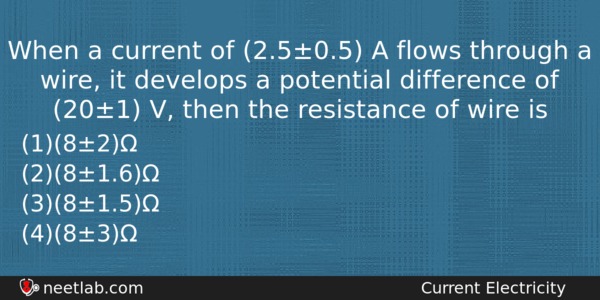| ⇦ | 
| ⇨ |
When a current of (2.5±0.5) A flows through a wire, it develops a potential difference of (20±1) V, then the resistance of wire is
Options
(a) (8±2)Ω
(b) (8±1.6)Ω
(c) (8±1.5)Ω
(d) (8±3)Ω
Correct Answer:
(8±2)Ω
Explanation:
No explanation available. Be the first to write the explanation for this question by commenting below.
Related Questions: - Rate of photoelectric emission is proportional to
- A series L-C-R circuit contains inductance 5 mH, capacitance 2 μF and resistance
- The magnifying power of the astronomical telescope for normal adjustment is 50.
- Which one of the following statements is not correct in case of a semiconductor?
- In potentiometer experiment, a cell of emf 1.25V gives balancing length of 30 cm
Topics: Current Electricity
(136)
Subject: Physics
(2479)
Important MCQs Based on Medical Entrance Examinations To Improve Your NEET Score
- Rate of photoelectric emission is proportional to
- A series L-C-R circuit contains inductance 5 mH, capacitance 2 μF and resistance
- The magnifying power of the astronomical telescope for normal adjustment is 50.
- Which one of the following statements is not correct in case of a semiconductor?
- In potentiometer experiment, a cell of emf 1.25V gives balancing length of 30 cm
Topics: Current Electricity (136)
Subject: Physics (2479)
Important MCQs Based on Medical Entrance Examinations To Improve Your NEET Score
18000+ students are using NEETLab to improve their score. What about you?
Solve Previous Year MCQs, Mock Tests, Topicwise Practice Tests, Identify Weak Topics, Formula Flash cards and much more is available in NEETLab Android App to improve your NEET score.
Share this page with your friends

R=V/I
R=20/2.5
R= 8 ohm
Now,
∆ R/R=∆ V/V+∆I/I
=1/20 +0.5/2.5
= 1/4
Therefore,
∆ R÷R=1÷4
∆ R=1÷4×R
∆R=1÷4×8
∆R=2
Therefore,
Resistance with error limits=R+ – ∆R
=(8+ – 2)ohm